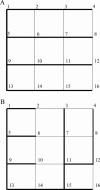How to impose microscopic reversibility in complex reaction mechanisms
- PMID: 15189850
- PMCID: PMC1304255
- DOI: 10.1529/biophysj.103.038679
How to impose microscopic reversibility in complex reaction mechanisms
Abstract
Most, but not all, ion channels appear to obey the law of microscopic reversibility (or detailed balance). During the fitting of reaction mechanisms it is therefore often required that cycles in the mechanism should obey microscopic reversibility at all times. In complex reaction mechanisms, especially those that contain cubic arrangements of states, it may not be obvious how to achieve this. Three general methods for imposing microscopic reversibility are described. The first method works by setting the 'obvious' four-state cycles in the correct order. The second method, based on the idea of a spanning tree, works by finding independent cycles (which will often have more than four states) such that the order in which they are set does not matter. The third method uses linear algebra to solve for constrained rates.
Figures





Comment in
-
On imposing detailed balance in complex reaction mechanisms.Biophys J. 2006 Aug 1;91(3):1136-41. doi: 10.1529/biophysj.105.071852. Epub 2006 May 12. Biophys J. 2006. PMID: 16698778 Free PMC article. No abstract available.
References
-
- Colquhoun, D., and A. G. Hawkes. 1982. On the stochastic properties of bursts of single ion channel openings and of clusters of bursts. Philos. T. Roy. Soc. B. 300:1–59. - PubMed
-
- Colquhoun, D., and A. G. Hawkes. 1987. A note on correlations in single ion channel records. Proc. R. Soc. Lond. B. Biol. Sci. 230:15–52. - PubMed
-
- Colquhoun, D., and A. G. Hawkes. 1995. The principles of the stochastic interpretation of ion channel mechanisms. In Single Channel Recording. B. Sakmann and E. Neher, editors. Plenum Press, New York. 397–482.
MeSH terms
Substances
Grants and funding
LinkOut - more resources
Full Text Sources

